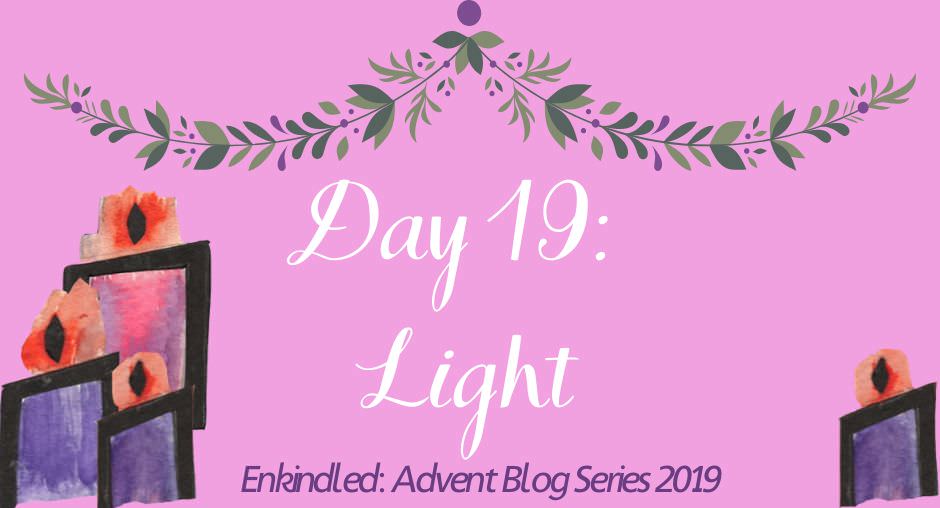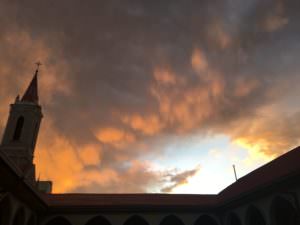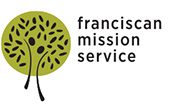Advent Day 19: Light

Editor’s note: FMS Missioner SarahJane Cauzillo currently serving in Cochabamba, Bolivia offers an Advent reflection ‘light’.
It is the rainy season here in Bolivia. In just a moment, a clear blue sky can be completely transformed as the dark clouds come rolling over the mountaintops. The sun can be covered in an instant as the pelting rain begins and the thunder bellows and echoes throughout the valley of Cochabamba. When at last the earth has drunk her fill and the rain pitters to a halt, the clouds – still pregnant and plump with water – linger in clumps, exposing the sky to us once again in patches. As the sun has begun setting in this last month, the reflecting light’s rays on these lingering rain clouds have given us a kaleidoscope of burning reds, oranges, yellows, and pinks. The clouds after the storm provide a canvas for the setting rays to dance and lay on; I have been stopped dead in my tracks in the evenings as I look up and see the mural of colors painted in the sky. I am reminded that the stark beauty of light is not seen in an absence of darkness, but often is rather manifested all the more gloriously when in contrast with the shadow of darkness.
I think it is impossible to talk about or reflect on light without also mentioning her brother, darkness. I do not need to remind anyone about how dark the world seems today – personally, familialy, socially, culturally, politically. And I think for many the temptation in this season is to ignore the darkness. To string up as many lights as possible and wrap everything in glitter – to keep the darkness outside “where it belongs.” I too am tempted often to seek light by ignoring darkness. Whether that be an acceptance of my ignorance, or as avoiding conflict or uncomfortable situations, or as avoiding letting feelings sink in. But, I have found in my experience of accompaniment at Nuestra Casa that in order to love and hold onto the hope and the light, I have to be able to sit in the darkness. It is a lesson in walking in, sitting alongside, and offering my presence as loved ones go through their own personal dark night.
This balance, this equanimity, of being in the darkness and holding onto light is being taught to me by the girls and the Tías at the hogar. Their true, authentic, healing, shining selves illumine the darkness, which they are simultaneously aware of and holding in respect. As Bolivia has experienced political upheaval, civil unrest, violence, and oppression, I have stood in awe as my Bolivian friends teach me how to exist in the post-thunderstorm sunset. In the midst of crisis, their examples of analysis, reflection, solidarity, and strength teach me what it means to enter into the darkness—to acknowledge the thick and dark storm clouds as they threaten us.
Meanwhile, their celebrations of Todos Santos with loved ones, Quinceañeras, walks in the park, baby showers, and the laughter that fills our every day has taught me gratitude, joy, and the meaning of presence in entirely new ways. I am learning that we do not wait for the darkness to pass nor do we try to ignore it or cover it up in order to experience the light. These moments of joy and celebration in the last month have even been more special because we know the contrast of darkness.
They are teaching me that we are not waiting for the light to come from somewhere else, nor do we need to look far for it. Light is born and cultivated and shines forth from within. As the Quakers say, “Our conscience is the Light of God in every person.” Every person has this sacred light. To say “Namaste” or to say “Christ be with you” or to say… whatever it is you like to say to express that sentiment, is an acknowledgement of the divine light (or the Holy Spirit) in me greeting the divine light in you, and meeting the divine light all around us. I am learning what it means to see that the light is right here amidst us already – right alongside and dancing in the storm clouds.
Only through experiential knowing – through the privilege of walking with the girls and women at Nuestra Casa – have I come to understand that “we are led forward by brightness, a larger force field, that is willing to include the negative, the problematic, the difficult, the unknown, [the darkness,] all of which I do not fully understand…” (Richard Rohr). We can recognize the brightness of light because we also know the pain of darkness.
Out of the formless void and darkness came light (Genesis 1:3). Out of the dark Palestinian night in a stable came Jesus. Out of the pain and sorrow of violence came the smiles and healing of all the girls of Nuestra Casa. Out of the strife and conflict of a post-election Bolivia came Quinceañeras and baby showers. Out of the storm clouds of the rain season came the sunset’s masterpiece. When we choose to see the light that is present within the darkness, rather than waiting for it to pass; when we trust we have the light of God from within us; when we recognize it in every thing and everyone we see, I believe we are truly experiencing the light of the Kingdom of God.
“The light shines in the darkness and the darkness did not overcome it” (John 1:5). For a long time, I thought I had to “get rid of” darkness – I would choose to only recognize the “light,” and therefore would experience joy and peace. But the storm clouds and my friends here have taught me that darkness is the brother to light. It is an inevitability that should not lead us to apathy, but rather to an acceptance that darkness will be present in our lives. In turn, we should be present to it. Because the shadow, darkness’ cousin, will help the light transform us all the more deeply and radically. In this season, I am learning to accept the darkness, to ask him to take a seat next to, alongside of, and in equanimity with, his sister, light.
Through this way of acceptance and balance – rather than rejection, ignorance, or apathy – I believe we can put into practice some ideas put forward by Cynthia Bourgeault, paraphrased here: if we can “see from a resonant wholeness—what we see is the Kingdom of Heaven, that we are co-creating. We can bring the light [our light, our recognition of the light already present] and go into the dark [and be at greater acceptance with the dark that is already present] and change those dark places… by the light itself.”
As legend has it, Jesus the Christ was born at night and the star above the stable would not have been seen to be shining bright without that dark night sky. So, this Advent season, may we welcome the light with healthy acknowledgement of the dark. May we let this duality transform us; may we touch our own inner light and recognize the divine light in everyone and everything else. May the image of light in the darkness be our image of hope now and at all times.
Tagged in:

